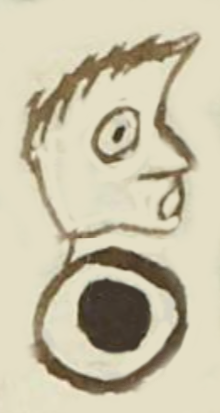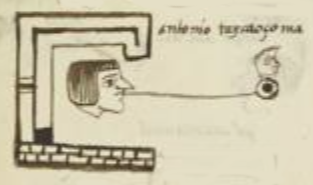Tezcaozoma (MH857r)
This black-line drawing of the compound glyph for the personal name Tezcaozoma (literally, “Mirror-Monkey”) is attested here as a man’s name. The glyph shows the head of a monkey (ozomatli) in profile, facing toward the viewer’s right. It has spiky hair, a round mouth, and a large round eye. Below this–and connected to the monkey by a short line–is a small mirror (tezcatl), which comprises two concentric circles. The inner circle is filled in with black paint, representing the polished obsidian that would provide for reflections.
Stephanie Wood
The monkey is a day sign in the tonalpohualli 260-day religious divinatory calendar. Children born under the sign of 1-Monkey had a destiny related to song and dance, writing and painting [see Isabel Laack, Aztec Religion and Art of Writing (2019, 163)]. According to the Werner-Forman Archive, the ozomatli was also considered the companion spirit (‘nahual’) and servant of Xochipilli (divine force of music and dance). See: https://www.mexicolore.co.uk/aztecs/artefacts/weekly/ozomatli.
Obsidian mirrors also had a sacred value, having an association with the highest leadership and approved by the divine force called Tezcatlipoca (“The Mirror’s Smoke”). See Aztecs/Azteken, an exhibition catalogue, eds. Doris Kurella, Martin Berger and Inés de Castro, at the Linden Museum, Stuttgart; published by Hirmer Publishers of Germany and INAH of Mexico (2019, 309).
One can imagine the obsidian mirror as a tool for starting a fire. A mirror could be an adornment on clothing. It could be a practical or a spiritual way of looking at one's face. In this collection, one will notice that profile views are much favored over frontal views of faces. Perhaps frontal views were perceived to be too direct or too powerful for normal purposes. Looking at rulers, such as Motecuhzoma, in the face was something controlled, too, possibly because of his perceived divinity. Frontal views of faces are often found on glyphs such as teotl (divinity), tonatiuh (sun), tonalli (sun/day), deity sculptures (e.g., nenetl), skulls, and an occasional animal (e.g., especially the tecolotl, or owl, which may have been perceived to have special powers, given that the tlacatecolotl was a supernatural being). Specifically "face" (xayacatl) glyphs are sometimes given in a frontal view, too.
Stephanie Wood
antonio tezcaoçoma
Antonio Tezcaozoma
Stephanie Wood
1560
Jeff Haskett-Wood
monos, espejos, nombres de hombres

tezca(tl), a mirror, https://nahuatl.wired-humanities.org/content/tezcatl
ozoma(tli), a monkey, https://nahuatl.wired-humanities.org/content/ozomatli
Espejo-Mono
Stephanie Wood
Matrícula de Huexotzinco, folio 857r, World Digital Library, https://www.loc.gov/resource/gdcwdl.wdl_15282/?sp=786&st=image.
This manuscript is hosted by the Library of Congress and the World Digital Library; used here with the Creative Commons, “Attribution-NonCommercial-ShareAlike 3.0 License” (CC-BY-NC-SAq 3.0).





